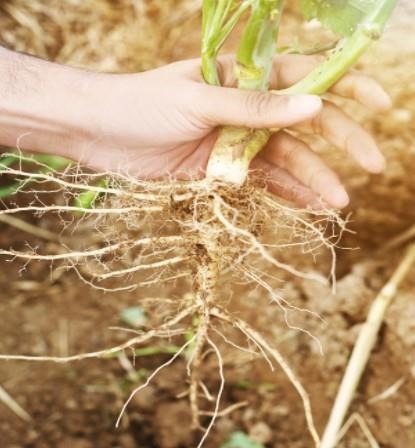By Jane Callier
Healing the Earth by Healing the Soil – Maximize Living Roots, Minimize Soil Disturbance
This is the third post in this series following concepts and information from UC Master Gardeners of Napa County presentation, “Soil is the Solution, healing the earth one yard at a time,” https://www.youtube.com/watch?v=JqA8DqBtRuo . The presentation describes practices we can learn and implement about soil to help slow and ultimately reverse the damage humankind has done. Previous posts were May 24 & June 7, 2021.

Roots, roots, roots
It's easy to see how a healthy mass of roots benefits a plant, but there is a lot more going on with roots than making a healthy plant. Roots need carbon to grow and plants have the capability of drawing carbon from the atmosphere. Carbon dioxide, of course, is a major contributor to greenhouse gas and global warming.
What we're looking at when we inspect healthy roots is not just roots themselves. Through photosynthesis plants create carbon sugars to feed their own growth and deliver it to the soil via their roots.
As roots exude carbon sugar, mycorrhizal fungi are drawn to them, and the active chemistry and microbiology that happens between them in this narrow area around the roots is called the rhizosphere. Part of the mycorrhizae are their hyphae, garden hose like structures that can extend 300 yards. They attach to roots, creating an immense root system. Mycorrhizae metabolize more root sugar, plants grow, pull down more carbon from the atmosphere, and roots transfer minerals absorbed from the soil into the plant. Both plants and soil structures benefit from the interaction.
We're looking at a soil biome that we might compare to a bustling city: busy freeways, construction workers and lots of food trucks and bistros. What happens when we don't have plants, roots and microorganisms creating all this life in the soil and performing this scientific, yet magical dance? As one of the presenters commented, “without (it) we just have geology.”
Organically grown food from a biome we just described has a higher nutritional value. Several minerals are present in significantly higher amounts that contribute to overall health and help combat inflammatory ailments like Alzheimer's and heart disease.
Holding it all together
We have already learned that tilling the soil grinds up the soil biome, destroys microorganisms in our bustling soil community and leaves us only dirt, or, as mentioned above, “geology.”
The soil fungi hyphae in healthy soil make a protective coating called glomalin that literally holds the soil together, making soil into an aggregate. A healthy biome without aggregated soil cannot exist. A demonstration in the presentation made this easy to understand. One plate had a mound of flour on it representing tilled soil. Next to it was a plate with a piece of bread on it representing aggregated soil. Water poured on the flour ran off, penetrating nothing. The bread absorbed the water as does aggregated soil, keeping carbon, nitrogen and minerals in the ground. Aggregated soil has been likened to a “carbon sponge.”
We can create aggregated soil to maximize living roots by planting perennials and trees, both having roots that stay in the ground for a long time. A vegetable garden can be intercropped, that is, planting seedling cool season vegetables beside mature warm season crops that are nearing the end of their harvest. Becoming more and more popular is the practice of planting perennial fruits and vegetables. Common ones are artichokes, asparagus and strawberries. The goal is to have roots in the ground year-round. Our soil has degenerated to such an extent that the establishment of more plants and their roots can be a lifeline as the earth's climates heat up.
We need to overcome the habit of tilling the soil. As much as possible, we need to leave soil intact. Soil is made up of sand, silt or clay, water and air. Only 5% of soil is made of organic matter. Of this 5%, only 5% is made of living organisms. This is indeed a precious commodity, and most of it occurs in topsoil, the top two inches of soil.
Our takeaways are these:
- Protect our soil biome and the rhizosphere.
- Keep the soil aggregate intact and functional.
- Retain healthy topsoil and protect it from erosion.
Source : ucanr.edu